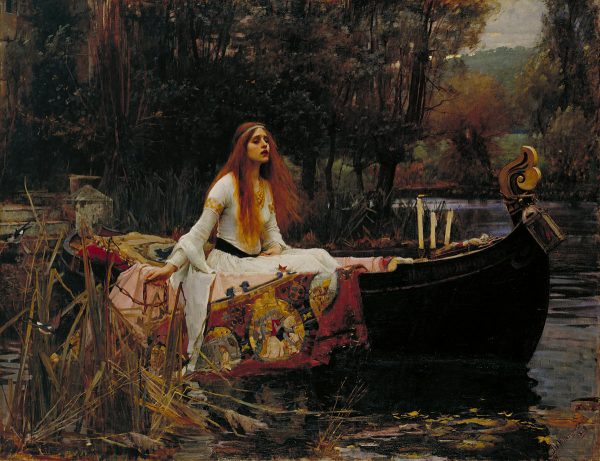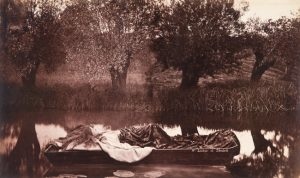Analysis of the Painting Lady of the Shallot
The Lady of the Shalott is an 1888 oil painting by John William Waterhouse. The painting was inspired by Alfred, Lord Tennyson’s poem of the same name, about the Arthurian maiden who was in love with Sir Lancelot.
The girl, who is loosely based on Elaine of Astolat has an unrequited love for Sir Lancelot. She is isolated due to a curse and is locked in a tower near King Arthur’s Camelot. Waterhouse painted three versions of this in 1888, 1894, 1915.

A basic reading of the painting will suggest that the Lady of the Shalott is on a boat, having just left her island. She is dressed in virginal white clothes with a crucifix and a rosary which suggests spirituality.
The prow resembles a small altar with a crucifix and three candles near the bow and the Lady is gazing over it. This suggests the boat as a place of worship and the candles signifying lives. Here, two out of the three candles are out. The Lady is sitting on a tapestry which is being dragged shabbily in the water.
The intricacy of the work on the tapestry shows Waterhouse’s attention to every minute detail. The background is indistinct and takes on a brushy quality. The fallen leaves denote that autumn is nearing. However, the fallen leaf on the woman’s lap denotes the loss of her innocence, the Lady as the single fallen leaf and her impending death.
Women as the subject of Lady of the Shallot
The painting reflects upon the times of how vulnerable and weak a woman seemed to be when she was outdoors and alone. She is facing her destiny and the expression on the woman’s face suggests her fear, which can be due to her future or for her safety.

Above – Henry Peach Robinson’s version of Lady of the Shallot
However, rather than blaming her for going out alone and bringing her fate upon herself, the lady invokes pity in the viewer. Waterhouse portrays the woman with an emotional depth which is unheard of in a woman in the 1800s. The power in the painting shows the helplessness of the woman, without power or title and completely at the mercy of the men coming for her.
Waterhouse’s use of Colours in Lady of the Shallot
Waterhouse’s denotation of the forest is thick, with muted color tens. He gives an earthy tone to the ground and a muted gray to the sky. This brings out the solemnity of the situation. The background resembles a funeral barge and it contrasts with the rich colors of the tapestry.
This depicts the colorful life she saw in her magic mirror. the light which is shining through the clouds highlights the broken reeds in the foreground. This also predicts the Lady’s imminent death.
Lady of Shalott Painting
The painting is a representation of the Pre-Raphaelites with the bright colors associated with the era. In the poem, the curse is put on her to stay in the tower and not look outside. However, in the poem, she defies the curse and the rules of confinement to get a glimpse of the outer world and this moment is captured in the painting by Waterhouse.
Lady of the Shallot is considered one of Waterhouse’s most realistic paintings for the color schemes, the woman and the expression of sorrow on her face, and the bold brush strokes of nature behind her.
Waterhouse’s close attention to detail and color, accentuation of the beauty of nature, realist quality, and his interpretation of a vulnerable, yearning woman is further representative of his artistic skill.
More Info On- Text of the poem: The Lady of Shallot, The Inspiration, and Explanation, John William Waterhouse